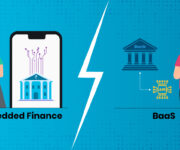Fintech-as-a-Service (FaaS) is making waves in this age of aggressive digitalisation. Traditional financial and non-financial companies use FaaS to make their solutions more effective and customer-friendly. FaaS uses cutting-edge technology to assist different industries, including lending, credit, and payments, overcome long-standing challenges.
When you add in the growing popularity of digital systems like online financing, wealth management, and robo-advisors, FaaS becomes an essential aspect of the urban ecosystem that is fast-moving to rural areas.
For the first time, traditional banks have found themselves up against some serious competition in terms of popularity because of the optimisation potential that Fintech infrastructure provides. As a result, legacy financial institutions are losing ground to these newcomers in the market.
As the Fintech business continues to grow, Fintech-as-a-Service applications may become the trend of 2022.
Fintech-as-a-Service (FaaS): What is It?
Fintech-as-a-Service allows companies to use Fintech APIs to embed financial capabilities into their existing products, services, and applications.
FaaS solutions comprise:
- White-label e-wallet platforms
- Payment acceptance,
- Card issuing,
- Payouts and remittances,
- Fraud prevention,
- Identity verification,
- Merchant services,
- Virtual accounts, and
- Provisioning, managing, and reporting solutions.
FaaS outsources the infrastructure, integration of multiple, disparate financial systems, licencing, and compliance, allowing businesses to quickly integrate and offer a wide range of financial services to customers previously only available through traditional banking and financial institutions.
Fintech-as-a-Service (FaaS): Global Trends
Over the projected period, the global Fintech-as-a-service market is expected to rise significantly. The increase in bank investments in innovative technology to improve their services and customer experience might be linked to market expansion.
Financial institutions seeking a cost-effective approach to optimise their end-to-end processes and stay in compliance with banking rules are increasingly turning to Fintech-as-a-Service or the provision of financial technologies as a service.
At the same time, the advantages of FaaS systems, such as low maintenance fees, low processing fees, fraud and chargeback protection, and greater customisation, are driving demand.
Banking technology firms are forming partnerships with FaaS providers to expand their products. These improvements are aimed at assisting banks in improving their customer service.
Bankers are increasingly demanding hassle-free and streamlined access to loan services and products, necessitating the development of enhanced FaaS platforms among financial institutions.
An increase in loan applications can make it difficult for banks with a small workforce to process all requests within the timeframe set. By transferring repetitive and tedious work to automated processes, the integration of Robotic Process Automation (RPA) functions in Fintech-as-a-service platforms allows banks to optimise and accelerate the loan process while avoiding errors.
The Upsurge of Fintech-as-a-Service (FaaS) and What This Implies for the Global Economy
Fintech’s emergence has served as a wake-up call for traditional financial institutions. For years, customers have desired more affordable and convenient banking options, yet traditional banks have typically trailed behind in technology advancement.
Moreover, established banks seldom had to worry about fresh competition due to regulatory limits in the finance industry. As a result, the cost of financial services has remained steady for over a century.
However, banks can no longer ignore Fintech’s relevance or rely solely on their reputation to keep customers. On the other hand, traditional financial institutions do not need to be concerned about Fintech’s growing popularity.
Traditional banks can use their technology skills to build tailored solutions for their clients by collaborating with Fintech start-ups. For instance, APIs (application programming interfaces) can now be built to work with a bank’s current technology.
Legacy banking’s strength mixed with digital businesses’ agility can allow traditional banking and cutting-edge technology to function together. As a result, Fintech-as-a-service will guide legacy financial institutions into the twenty-first century and transform the future of finance.
Fintech is here to stay
Let’s take a moment to appreciate how Fintech has transformed the money management game.
Certain financial mobile apps have been introduced in recent years, allowing smartphone users worldwide to instantly transfer money from their bank accounts with the touch of a screen.
Earlier, people used to wait in line at a Western Union or wait 2-5 days for a wire transfer to send money overseas.
Fintech applications can allow banking institutions to transfer money, withdraw funds, and convert currency online, giving some of the most significant banking access to cutting-edge technology.
Furthermore, Fintech-as-a-Service firms assume responsibility for the regulatory aspect of their work, which is one of the most difficult challenges to overcome when developing apps that manage sensitive data.
Fintech and digitalisation, in general, have been greatly influenced by Covid-19. As entire populations were compelled to work remotely due to the lockdown, the ability to execute tasks online became increasingly important.
Moreover, even the most technologically illiterate were compelled to learn things online, and tech stocks skyrocketed. As a result, Covid-19’s unique situation has pushed Fintech adoption across all age groups.
Can Fintech-as-a-Service Replace Traditional Banks in the Future?
Not really. Fintech companies and banks currently benefit from collaborating rather than competing in the market.
Why do banks need Fintech?
Fintech’s strength lies in its capacity to revolutionise basic financial transactions by making them more straightforward, convenient, and less expensive.
As a result, traditional banks can improve their services and expand their customer base by leveraging Fintech’s creative ideas.
FaaS businesses generally provide cutting-edge technology, slick aesthetics, and a superior user experience than financial institutions’ applications.
This makes sense because banks’ primary expertise is finance, not technology.
Furthermore, banks that design their apps must invest a significant amount of time in acquiring the necessary developers, cybersecurity specialists, and regulatory advisers before they can even start planning the pipeline of a new online service.
However, the technology is nearly immediately ready to use when using a FaaS provider.
Many FaaS providers include customisation, allowing banks to use their APIs’ colours, logos, and images. Therefore, customers will often be unaware that they use third-party technology when completing transactions with their trusted partners.
FaaS integrations also relieve banks of the burden of software maintenance, which can be time-consuming and costly. In addition, FaaS providers are solely responsible for prioritising cybersecurity and keeping their platforms current.
Why Fintech needs legacy financial institutions
New technology can be exciting, but when it comes to their hard-earned money, few people want to be anything but conservative. While bank alternatives have received a lot of attention in recent years, it doesn’t appear that there will be a significant shift away from traditional banks in favour of Fintech.
People like to put their money in well-known, well-established institutions. They are comforted by the knowledge that they can come into their local branch and chat with someone if they have an issue, even if they do so infrequently (if at all).
Customers are usually anonymous when using financial apps, and the technology industry has a poor reputation for customer support. Fintech companies can obtain access to customer data by partnering with banks, which will help them customise their products and marketing to reach a bigger audience.
In the austere world of finance, Fintech and alternative investment options such as cryptocurrencies and non-fungible tokens require banks to lend them reputability and legitimacy.
The Bottom Line
Legacy banking organisations recognise the value of technology in reducing the time and cost of processes for their customers. Fintech companies, formerly seen as competitors by traditional banks, have evolved into valuable partners.
Banks may deliver exceptional customer care and convenient online solutions to their clients by leveraging the experience of Fintech-as-a-Service firms. Financial technology can become more secure and accessible for everyone if stakeholders work together.
Finezza is a cutting-edge lending lifecycle management technology that streamlines the process for Indian financial lending firms. This FaaS platform provides a unique document recognition and data extraction module for its clients.
The software uses deep learning technology to identify the type of document it’s looking at swiftly. Optical Character Recognition (OCR) is used to detect fields (OCR).
The FaaS platform uses Object Detection techniques to extract the required fields and crop the image for data extraction. It automates the entire lending process, from origination to evaluation, allowing traditional lenders to process a huge volume of loans quickly.
Reduced loan application turnaround time improves customer satisfaction and contributes to the profitability of the lending firm.




Leave a Reply